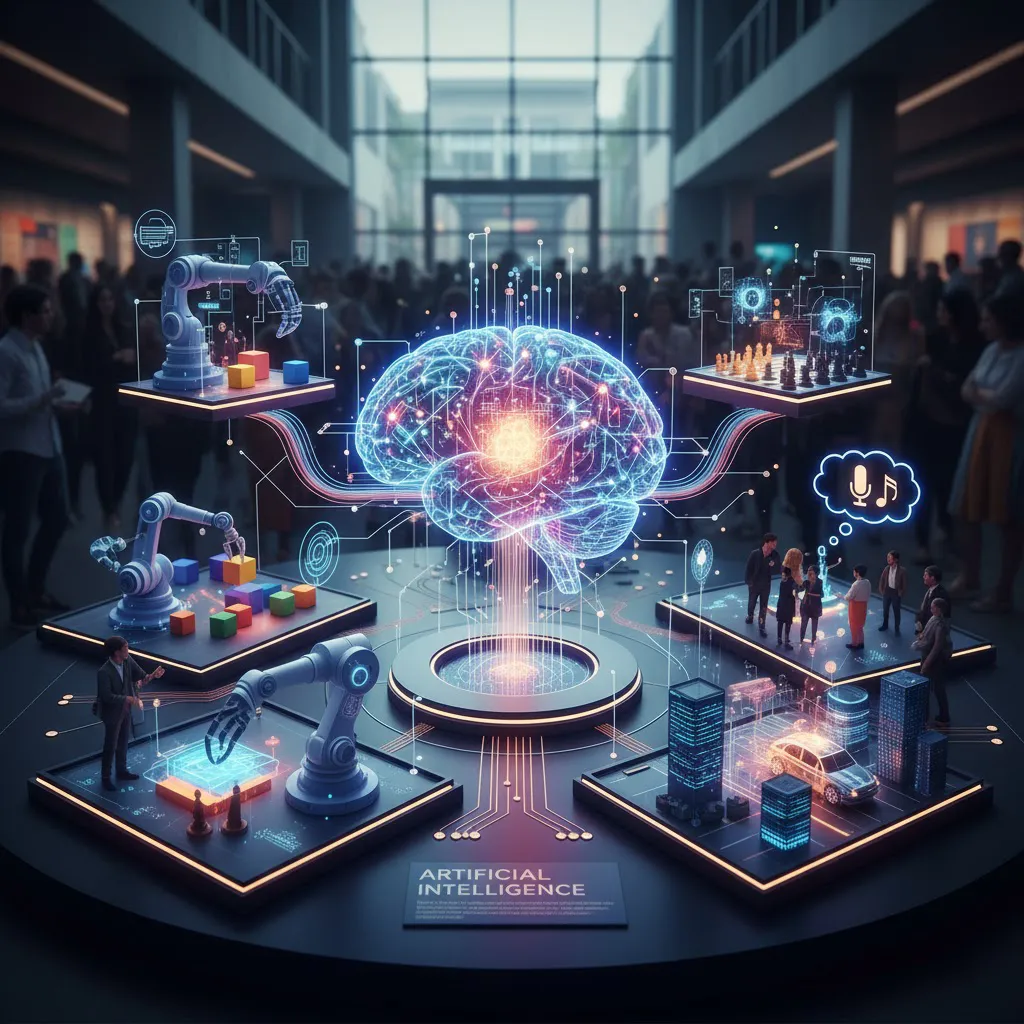Artificial Intelligence Explained: Understanding AI in the Modern World
In recent years, Artificial Intelligence (AI) has become one of the most transformative technologies in human history. From self-driving cars to chatbots and medical diagnosis systems, AI is reshaping nearly every industry.

But what exactly is AI, how does it work, and why is it so revolutionary? This article provides a detailed explanation of Artificial Intelligence - from its origins and types to its applications, challenges, and future - in a clear and comprehensive way.
1. What Is Artificial Intelligence?
Artificial Intelligence refers to the ability of machines or computer systems to perform tasks that typically require human intelligence. These tasks include learning, reasoning, problem-solving, perception, and understanding natural language.
Instead of being programmed for every single function, AI systems use algorithms that allow them to learn from data and improve their performance over time. In essence, AI enables computers to “think” and “learn” just like humans, but faster and at a larger scale.
Key Characteristics of AI
- Learning: The ability to acquire information and rules for using it.
- Reasoning: Applying logic to reach conclusions or make predictions.
- Self-correction: Improving performance based on feedback.
- Perception: Using sensors or input data to interpret the environment.
2. The History and Evolution of Artificial Intelligence
The concept of Artificial Intelligence has ancient roots. Stories of artificial beings appear in Greek mythology, but modern AI began in the 20th century.
Early Developments
In 1950, Alan Turing published his landmark paper Computing Machinery and Intelligence, introducing the Turing Test, which asked whether machines could “think.” In 1956, the term Artificial Intelligence was officially coined at the Dartmouth Conference, marking the formal birth of AI as a research field.
AI Winters and Revival
The following decades saw waves of optimism and disappointment. In the 1970s and 1980s, limited computing power and exaggerated expectations led to what is known as AI winters, when funding and interest declined.
However, with advances in machine learning, big data, and deep neural networks in the 2000s, AI entered a new golden age. Today, it drives technologies we use daily - from search engines to digital assistants and autonomous vehicles.
3. How Does Artificial Intelligence Work?
At its core, AI systems learn from data. They use algorithms to process information, recognize patterns, make predictions, and continuously improve their accuracy. The more data they receive, the smarter they become.
Core Components of AI
- Data: The raw material that powers AI models.
- Algorithms: The rules that guide how data is processed and decisions are made.
- Computing Power: High-performance processors that handle massive datasets quickly.
For example, an AI model trained on thousands of medical images can learn to identify tumors or diseases with high accuracy, sometimes even surpassing human doctors.
4. Types of Artificial Intelligence
AI can be categorized based on its level of capability and function. Generally, there are three main types:
Narrow AI (Weak AI)
This is the most common form of AI today. It is designed to perform a specific task, such as facial recognition, speech translation, or recommendation systems. Examples include Siri, Alexa, Google Assistant, and ChatGPT.
General AI (Strong AI)
This level of AI would have human-like intelligence, capable of understanding, learning, and applying knowledge across various domains. True General AI does not yet exist, but it is a long-term goal for researchers.
Superintelligent AI
This hypothetical form would surpass human intelligence in every aspect - creativity, reasoning, and problem-solving. While it remains theoretical, Superintelligent AI raises major ethical and philosophical debates about humanity’s future.
5. The Main Subfields of Artificial Intelligence
Artificial Intelligence is a broad field made up of many specialized areas. Each focuses on a different aspect of simulating human intelligence.
Machine Learning (ML)
Machine Learning teaches computers to learn from data instead of being explicitly programmed. Using algorithms such as decision trees or regression models, ML enables systems to find patterns and make predictions.
Deep Learning (DL)
Deep Learning is a branch of ML that uses neural networks with multiple layers to process complex data such as images, video, and audio. It powers technologies like autonomous driving and voice assistants.
Natural Language Processing (NLP)
NLP allows computers to understand and generate human language. It’s used in chatbots, translation tools, and sentiment analysis systems that interpret social media or customer feedback.
6. Real-World Applications of Artificial Intelligence
AI is not just a futuristic concept - it’s already integrated into everyday life and business operations.
Healthcare
AI helps doctors interpret medical images, predict disease risks, and recommend treatments using predictive analytics. AI-driven robots can even assist in surgeries with greater precision.
Finance
Banks and financial institutions use AI algorithms for fraud detection, credit scoring, and automated trading, ensuring faster and more secure operations.
Transportation
AI powers self-driving cars, improves traffic flow in smart cities, and optimizes delivery routes for logistics companies.
Marketing and E-commerce
Online platforms use AI to recommend products, personalize ads, and predict customer behavior. This improves customer experience and increases sales conversion rates.
7. Benefits of Artificial Intelligence
The advantages of AI technologies extend across all sectors of the economy.
Efficiency and Productivity
AI automates repetitive and time-consuming tasks, allowing humans to focus on creativity and strategy. It reduces human error and boosts accuracy in data-driven processes.
24/7 Operation
Unlike people, AI systems do not need rest. They can function continuously, ensuring consistent quality and round-the-clock service.
Data-Driven Decision Making
AI can process vast amounts of information quickly, offering valuable insights that guide better business and policy decisions.
8. Challenges and Ethical Issues in AI
Despite its benefits, Artificial Intelligence also presents significant challenges and ethical concerns.
Job Displacement
Automation may replace certain jobs, especially in sectors like manufacturing, logistics, and customer service. This raises concerns about unemployment and the need for new skill development.
Bias and Fairness
AI systems are only as unbiased as the data they are trained on. If data contains prejudice, AI may produce discriminatory results, impacting hiring, law enforcement, or lending decisions.
Privacy and Security
AI requires massive data sets, often including personal information. This creates potential risks related to data privacy, surveillance, and cybersecurity breaches.
9. The Future of Artificial Intelligence
The future of AI is both promising and uncertain. New developments in generative AI, quantum computing, and autonomous systems could revolutionize how humans live and work.
Human-AI Collaboration
Rather than replacing people, future AI systems will likely collaborate with humans, combining computational power with human creativity. This hybrid approach will redefine productivity and innovation.
AI in Everyday Life
From personalized education and entertainment to smart homes and healthcare, AI will become even more embedded in daily routines, creating more seamless and connected experiences.
However, as AI grows more powerful, governments, organizations, and researchers must establish clear regulations and ethical frameworks to ensure it benefits society as a whole.
10. How to Learn and Build a Career in Artificial Intelligence
With AI reshaping industries, learning about it can open doors to some of the most in-demand careers today.
Key Skills to Learn
- Programming languages: Python, R, and Java.
- Mathematics: Statistics, probability, and linear algebra.
- Machine learning frameworks: TensorFlow, PyTorch, and Keras.
- Data analysis tools: NumPy, Pandas, and Scikit-learn.
Where to Learn
Online platforms such as Coursera, Udacity, edX, and Google AI offer beginner-to-advanced AI courses. Building personal projects, contributing to open-source work, and participating in hackathons can greatly accelerate your skills and career growth.
Conclusion
Artificial Intelligence has evolved from a theoretical idea into a technology that powers nearly every part of modern life. It enhances healthcare, fuels innovation, and transforms industries at an unprecedented pace.
However, with great power comes great responsibility. As we integrate AI deeper into our societies, we must address ethical challenges, data privacy, and fairness to ensure that this technology serves humanity’s best interests.
In the end, Artificial Intelligence is not just the future - it is already here, quietly shaping the way we live, work, and think. The question is no longer whether AI will transform our world, but how we will adapt and thrive alongside it.











